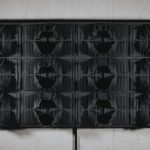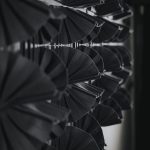Kadi Kibbermann
- Faculty of Design
- Textile Design
- ma
- Notice Noise: kinetic interior textile panel
- Tutor(s): Kristi Kuusk, Katin Kabun
The aim of this master’s thesis is to find a solution to how to notice a change in a noise level and how to reduce its level in the interior via the use of kinetic textile.
Textile as a material and textile techniques have constantly evolved throughout the history, but in recent decades both textile applications and its production technologies have remarkably expanded. One of the reasons is undoubtedly the overall rapid technological development which has led to its closer links to various disciplines from biology to engineering. This in turn makes it increasingly important for textile designers have cross-disciplinary knowledge to grasp the whole and to see the ever-expanding opportunities in this area.
One of the growing trends in textiles design is smart textiles, which have the ability to receive inputs using sensors, process them and then express them in some way.
React to, for example, discoloration, vibration, glow, or change in size or shape through motion – kinetics. This thesis has focused on the creation of kinetic textiles.
At the heart of this artistic research is a prototype of smart textiles, during the completion of which the necessary information is gathered and analysed from different fields: textiles, environment, electronics and acoustics. The completed work is an artistic design project which brings together various areas to enrich textile design and improve the environment around us.
The research problem of this master’s thesis was to notice the noise level in the interior and its reduction when using kinetic textiles. The main question was how to create a kinetic textile interior which responds to the impulse of noise with movement, draws the occupant’s attention to the increase in noise level and at the same time increases the noise absorption in the room.
Consequently, the research dealt with the nature of noise and its connection to textiles and brought out examples of how they have developed into designs that muffle excessive sounds in the room. Kinetic objects were also observed, and their kinetic architecture solutions were approached, which from their concept have inspired the creation of a kinetic textile panel completed within the framework of this master’s thesis.
The practical creative process covers the choice of the work material, the creation of the form, the construction of the panel and its mobility system and its connection to electronics.
Additionally, the research examined environmental aspects which are related to the combination of textiles and electronics. As a result, it was considered important to focus on the purpose as well as on the use of the materials and the recycling of the products elements once it reached the end of its life.
Through the synthesis of this knowledge, a textile panel responsive to the interior noise level was made using the origami technique. The movement of it was solved by motors which open and close the textile shapes on the panel. According to the indoor noise limits (80dB) established in the EV Act, the movement of the elements occurs in two different rhythms and patterns which are regulated according to the permissible noise level. When the value is below the set limit then the panels move quietly in a wavy rhythm pattern. When the noise level in the interior rises above the allowed limit, then the movement of the modules intensifies, during which the modules synchronously open and close. In addition to directing attention they also silence the noise level in the room by increasing the textile surface.
Using natural wool felt as a material, which in itself has very good sound-absorbing properties, the panels were tested in an acoustic laboratory to determine the sound absorption coefficient. As a result, an answer to the problem posed at the beginning of the thesis regarding noticing and reducing the noise was found. It was confirmed that the sound-absorbing properties can also be enhanced when experimenting with the shape of the form. When the motors opened the surface of the textile modules in a way that 3D images formed then as a result an increase in the sound absorption coefficient was recorded.
Thus, this thesis helps to solve the problem of noticing and reducing the noise level in the interior with the help of kinetic textiles.


